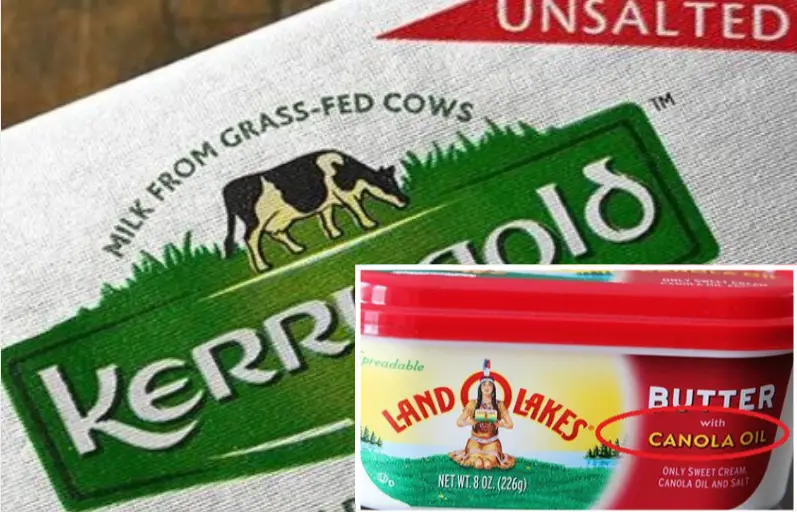
Butter is one of the staple foods in millions of households, and for good reason as it also happens to be one of the healthiest foods out there — as long as you buy the right kind, of course.
In 2005, butter finally broke loose from its nutritional banishment and reclaimed its top spot from longtime rival margarine, which was originally developed by a French chemist way back in 1869.
Lately butter sales have been spurred even more by health trends like the Paleo Diet and Bulletproof Coffee, which centers around mixing grass-fed butter with coffee for a nourishing and stimulating morning drink.
These dietary protocols are very particular about the type of butter allowed, however, which is a good thing considering the many pitfalls of the modern American grocery store.
Here are five things to look for the next time you’re in the butter aisle and want to make a healthier choice:
1. Grass-Fed is Best-
If you’ve ever tried Kerrygold Irish butter before (which by now you probably have considering it’s the second-best selling butter in the U.S.) you’ve probably noticed a huge difference between it and the so-called natural stuff served by Land O’Lakes and other companies.
Grass-fed butter is much higher in healthy Omega-3 fatty acids and Vitamin K2 than butter from cows eating grain-based diets, as well as in conjugated linoleic acid, a powerful and healthy substance that may help prevent heart attacks and can aid in weight loss.
One caveat: the term “grass-fed” is still not well regulated at all.
Be sure to know your supplier or farmer if you want 100% grass-fed butter.
[Related Reading: The One Thing Health Conscious People Haven’t Been Told About Kerrygold Irish Butter]
2. Organic is a Huge Improvement-
If you want to make sure your butter comes from cows that haven’t been fed GMOs or a Roundup-laced diet, look for organic butter (even Kerrygold may contain butter from cows fed up to 3% GMOs as of last count).
Organic butter is usually found under store name brands, and it’s well worth the price. Organic and grass-fed together is a match made in heaven.
3. Watch Out for Additives-
Food companies are sneaky, and they know how to get people to buy an inferior product by painting it as “healthy” or by hiding additives in the fine print.
If your butter isn’t organic and has canola oil, corn oil, or soy oil in it (all three are likely to come from GMO-derived sources), avoid at all costs. Non-organic and non-grass fed butter could also come from cows that have eaten high amounts of GMO content, which will cause more inflammation in the body and could lead to health problems.
Do you know where your meat comes from?
Get the best grass-fed, grass-finished meat and wild-caught seafood from our friends at Wild Pastures
Special offer, first-time customers only – Click Here (20% Off Your First Box With a $15 Bonus)
4. Country-of-Origin Matters-
If you want healthy butter and you’re in a pinch because of a lack of organic options, look for European butter or other imported brands (like Kerrygold, from Ireland, for example).
Other delicious alternatives such as Anchor butter (New Zealand) and Algau (Germany) are grass-fed as well. Keep an eye out for unique overseas brands like these and check the label for more info.
5. Avoid All “Monsanto Butter”-
As mentioned above, many top brands may claim to be natural, but are still from cows fed an unnatural diet of Monsanto GMO corn, soy, and even alfalfa (hay).
Consuming dairy from grain-fed cows leads to more inflammation in the body, a major precursor of disease. People who consume more grass-fed dairy with higher concentrations of CLAs in their diet also had a much lower heart attack risk (up to 36 percent), according to a study from Harvard researchers.
Grass-fed and organic are clearly worth the extra dollar or so — an investment in your health, and the health of the environment. These purchases add up, so make yours count.
Where to Buy the Best Quality Butter
As far as butter goes, the old saying never rings more true: knowing your farmer is the best way to assure a quality grass-fed and organic product.
If you can’t always find grass-fed or organic locally, do your best to “minimize the damage” by buying the most natural butter you can find.
For cooking purposes, you can’t go wrong with ghee, a type of clarified butter that is often grass-fed and can be found in health food stores, specialty websites and on Amazon.com (the Pure Traditions brand is grass-fed, cultured and organic with almost 70% five-star reviews).
I personally buy Kerrygold as much as possible because of the combination of convenience, price, health and taste. But there are plenty of other healthy grass-fed options like Organic Valley to try as well.
At the end of the day you really can’t go wrong, as long as you know your source and stay active to make sure you’re circulating that body-nourishing saturated fat throughout your system on a daily basis.
Thanks for reading! For more articles like these in your inbox, add your name and email address to the box on this page (don’t forget to try Wild Pastures’ pasture-raised goods for 20% off here)…
Thanks for installing the Bottom of every post plugin by Corey Salzano. Contact me if you need custom WordPress plugins or website design.




